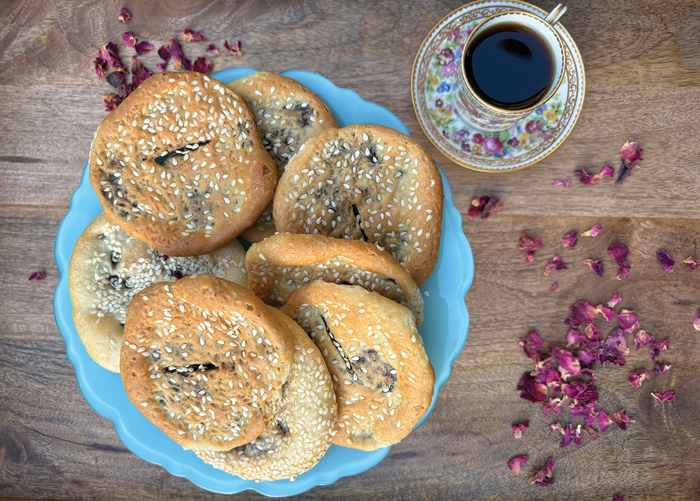 Photo by Sephardic Spice Girls
Photo by Sephardic Spice Girls In 1942, my dashingly handsome grandfather Aba Naji arrived in Al Azair, a village in the south of Iraq, not far from Basra.
Located on the shores of the west bank of the sweeping Tigris River and surrounded by tall lush palm trees, Al Azair is where my great grandfather Yosef was the Shamash (keeper) of the Tomb of Ezra ha’Sofer (the Scribe).
Considered a noble pilgrimage site, history records that as far back as the 11th century, merchants who traveled to India stopped at the tomb on their journeys back to Egypt and North Africa. Famous Jewish travelers Benjamin of Tudela (died 1173) and Yehuda Alharizi (died 1225) visited the tomb, as did generations of Iraqi Jews.
In 1843, the Chief Rabbi of Aleppo, Rabbi Avraham Antebi, wrote that it was the custom of Syrian Jews to visit the Tomb whenever there was sickness or trouble in the family. However, the Tomb was in an open orchard with no Eruv (halachic boundary around a property) causing people to transgress the Sabbath by carrying food and drink there. In 1775, this prompted Rabbi Shmuel Laniado to enact a ban on such visits. Rabbi Antebi writes that during the year of the ban, many afflictions befell the community. Many people dreamt that it was because they had stopped making these pilgrimages. He writes that Rabbi Yehuda Kassin forced Rabbi Laniado to rescind the ban on people visiting the holy site.
My grandfather, Aba Naji had been sent by the Iraqi Army to be a high school teacher in Al Azair and his accommodations would be in the large compound that housed the tomb, living with Yosef and his family and the boch’rim (young men) studying in the Yeshiva there. On his first evening there, he was seated with Yosef and Tova, their sons Rueben, Naji and Nuri, when the daughter of the house walked in bearing a tray filled with dried fruits and nuts and freshly baked pastries, including baba ta’mar (crispy date-filled cookies). As she poured him a cup of cardamom tea, my grandfather was taken by her silky curls, her shy smile and her gentle manners. My grandfather fell hard for the charms of my grandmother Nana Aziza and they married on March 17, 1943.

The Babylonian Jewish community had thrived for 2,600 years, but with the rise of Arab nationalism in the mid-twentieth century, the Jews had no choice but to leave. The Iraqi Jews rebuilt their lives, primarily settling in Israel and London.
My grandparents left for Israel with five young children and one suitcase in May 1951. There are no heirlooms. Just faith in Hashem, Jewish traditions, some black-and-white photos and my grandmother’s recipes.
More than any other food, I feel that baba ta’mar are a tangible reminder of my Babylonian roots. A thin four-inch round cookie made with a crispy, unsweetened dough, topped with sesame seeds and a soft, creamy date filling.
For Iraqi Jews, freshly baked baba ta’mar are one of the best ways of showing love.
Dates are the ultimate symbol of Middle Eastern hospitality, served with coffee and tea to greet guests. For Iraqi Jews, freshly baked baba ta’mar are one of the best ways of showing love.
—Sharon
Through the years of attending the Kahal Joseph Community Purim Bake and doing baking demonstrations with Sharon, I have mastered the art of baking these delicious cookies. They truly are the perfect treat—the crispy exterior of the yeast dough and nutty smattering of sesame seeds is a perfect foil to the deep caramel sweetness of the dates.
Sharon and I are very excited to host a Purim baking master class with Mickey Kahtan where we will demonstrate how to make baba ta’mar, Iraqi almond macaroons and my specialty, biscochos from the Rhodesli kitchen.
We hope you can join us on Monday March 18 at 7pm at Kahal Joseph Congregation.
Ba’ba Tamar Recipe
Date Filling
2 cups date paste
1/4 cup olive oil
3 Tbsp water
1/4 cup crushed walnuts
Combine dates and olive oil, then add water and walnuts until mixture becomes a smooth paste. Set aside.
Garnish
3 eggs
1 Tbsp honey
1 Tbsp water
1/2 cup sesame seeds
In a small bowl, beat together the eggs, honey and water. Set aside.
Dough Recipe
2 packets active dry yeast
1 tsp sugar
1 tsp kosher salt
2 cups warm water, divided
7 cups all purpose flour, sifted
1 cup avocado or vegetable oil
1 tsp fennel or nigella seeds
• In a small bowl, add warm water to yeast, sugar and salt. Cover and leave to proof for 10 to 15 minutes.
• In a stand mixer, add flour, oil, water, fennel seeds and yeast mixture and mix until a dough is formed.
• Remove dough from mixer bowl and knead the dough by hand until it is smooth and stretchy. Place the dough in an oiled bowl, then rub some oil on top of the dough. Cover with a kitchen towel, set aside in a warm spot for 1 hour.
• Remove the dough and knead for 2 minutes. Return to the bowl and let stand for 25 minutes.
• Preheat oven to 350°F.
• Divide the dough into four pieces. Grease hands with oil, pinch the dough into golf ball size balls and roll till smooth. Lay the dough balls on a greased baking sheet.
• Place a ball of dough into the palm of your hand, make a deep indentation into the dough and place half a tablespoon of date filling in the hole.
• Pinch dough closed. With a small rolling pin, roll the ball flat until it is about 4 inches in diameter. With the end of the rolling pin, make a few indentations in the center of the cookie. Place cookies on a baking sheet.
• Brush cookies with egg mixture, then top with sesame seeds.
• Repeat until all dough and date filling are used.
• Bake for 12 to 15 minutes, until golden and crispy.
Rachel Sheff and Sharon Gomperts have been friends since high school. They love cooking and sharing recipes. They have collaborated on Sephardic Educational Center projects and community cooking classes. Follow them on Instagram @sephardicspicegirls and on Facebook at Sephardic Spice SEC Food.























 More news and opinions than at a Shabbat dinner, right in your inbox.
More news and opinions than at a Shabbat dinner, right in your inbox.